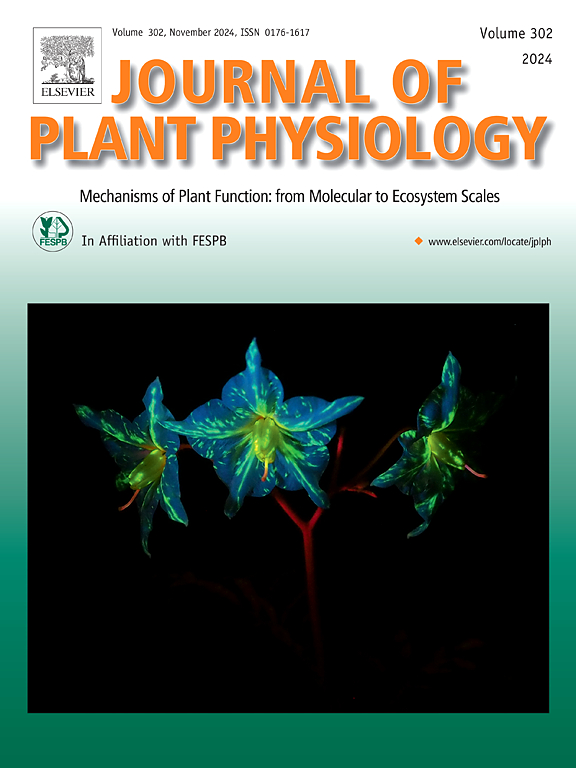Regulatory network of lncRNAs and mRNAs explains why salinity promotes photosynthesis and plant growth in the halophyte Suaeda salsa
IF 4.1
3区 生物学
Q1 PLANT SCIENCES
引用次数: 0
Abstract
Suaeda salsa L. exhibits strong salt tolerance, with 200 mM NaCl being the optimum salt concentration for its growth. However, the specific molecular regulatory network remains unclear. This study used high-throughput sequencing technology to identify the expression abundance of lncRNAs after 24 h of 200 mM NaCl treatment (S24). A total of 16533 novel_lncRNAs were obtained, mainly divided into 10764 lincRNAs (65.11 %), 4936 antisense (29.85 %), and 833 sense overlap (5.04 %). Comparing lncRNAs at S24 and CK revealed 231 up-regulated and 257 down-regulated lncRNAs detected. The differential target genes corresponding to lncRNAs were mainly enriched in carbon metabolism, glycolysis/gluconeogenesis, carbon fixation in photosynthetic organisms and glyoxylate and dicarboxylate metabolism. Comparing the mRNAs at S24 and CK, the up-and down-regulated genes were 998 and 776, respectively, which corresponded to those for lncRNAs. Further investigation revealed that a particular lncRNA, TCONS_00024624 (lnc24), interacts with three genes that collectively regulate ribulose bisphosphate carboxylase (Rubisco). The expression of target genes of lncRNAs and activity of Rubisco and GAPDH in the leaves of S. salsa were upregulated and increased at S24 compared with CK. In conclusion, the results suggest that lncRNAs play important roles in enhancing the photosynthetic capacity of S. salsa and promoting its growth at 200 mM NaCl. This provides new references for studying salt tolerance mechanisms in S. salsa.

lncrna和mrna的调控网络解释了为什么盐度促进盐生植物salsa的光合作用和植物生长
盐盐浓度为200 mM NaCl时,salsa L.具有较强的耐盐性。然而,具体的分子调控网络尚不清楚。本研究采用高通量测序技术鉴定了200 mM NaCl处理24 h后lncRNAs的表达丰度(S24)。共获得16533个novel_lncrna,主要分为10764个lincrna(65.11%)、4936个反义rna(29.85%)和833个重叠rna(5.04%)。比较S24和CK的lncrna,发现231个lncrna上调,257个lncrna下调。lncRNAs对应的差异靶基因主要富集于碳代谢、糖酵解/糖异生、光合生物的固碳以及乙醛酸盐和二羧酸盐代谢。对比S24和CK的mrna,上调和下调的基因分别为998和776,与lncrna对应。进一步的研究表明,一个特殊的lncRNA tcon_00024624 (lnc24)与三个共同调节二磷酸核酮糖羧化酶(Rubisco)的基因相互作用。S24处理后,salsa叶片中lncRNAs靶基因表达量和Rubisco、GAPDH活性均有所上调和升高。综上所述,在200 mM NaCl胁迫下,lncRNAs在提高salsa的光合能力和促进其生长方面发挥了重要作用。这为研究salsa耐盐机制提供了新的参考。
本文章由计算机程序翻译,如有差异,请以英文原文为准。
求助全文
约1分钟内获得全文
求助全文
来源期刊

Journal of plant physiology
生物-植物科学
CiteScore
7.20
自引率
4.70%
发文量
196
审稿时长
32 days
期刊介绍:
The Journal of Plant Physiology is a broad-spectrum journal that welcomes high-quality submissions in all major areas of plant physiology, including plant biochemistry, functional biotechnology, computational and synthetic plant biology, growth and development, photosynthesis and respiration, transport and translocation, plant-microbe interactions, biotic and abiotic stress. Studies are welcome at all levels of integration ranging from molecules and cells to organisms and their environments and are expected to use state-of-the-art methodologies. Pure gene expression studies are not within the focus of our journal. To be considered for publication, papers must significantly contribute to the mechanistic understanding of physiological processes, and not be merely descriptive, or confirmatory of previous results. We encourage the submission of papers that explore the physiology of non-model as well as accepted model species and those that bridge basic and applied research. For instance, studies on agricultural plants that show new physiological mechanisms to improve agricultural efficiency are welcome. Studies performed under uncontrolled situations (e.g. field conditions) not providing mechanistic insight will not be considered for publication.
The Journal of Plant Physiology publishes several types of articles: Original Research Articles, Reviews, Perspectives Articles, and Short Communications. Reviews and Perspectives will be solicited by the Editors; unsolicited reviews are also welcome but only from authors with a strong track record in the field of the review. Original research papers comprise the majority of published contributions.
 求助内容:
求助内容: 应助结果提醒方式:
应助结果提醒方式:


